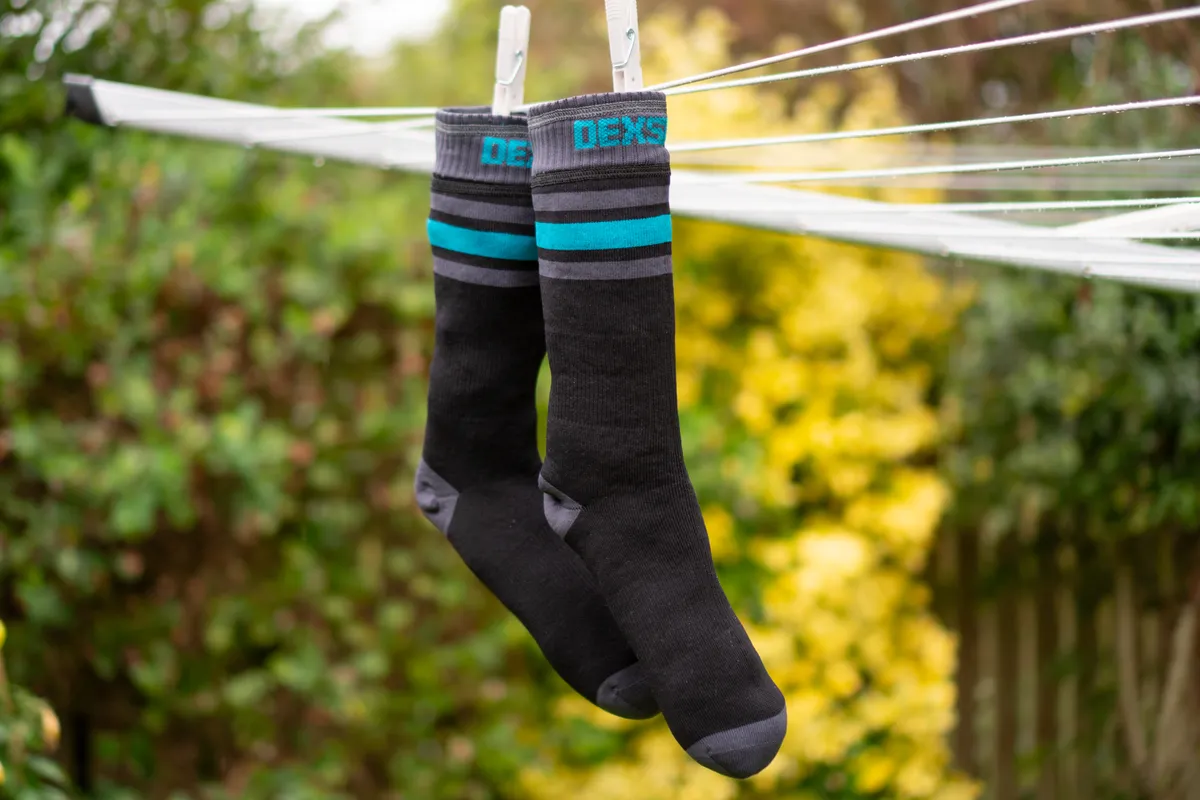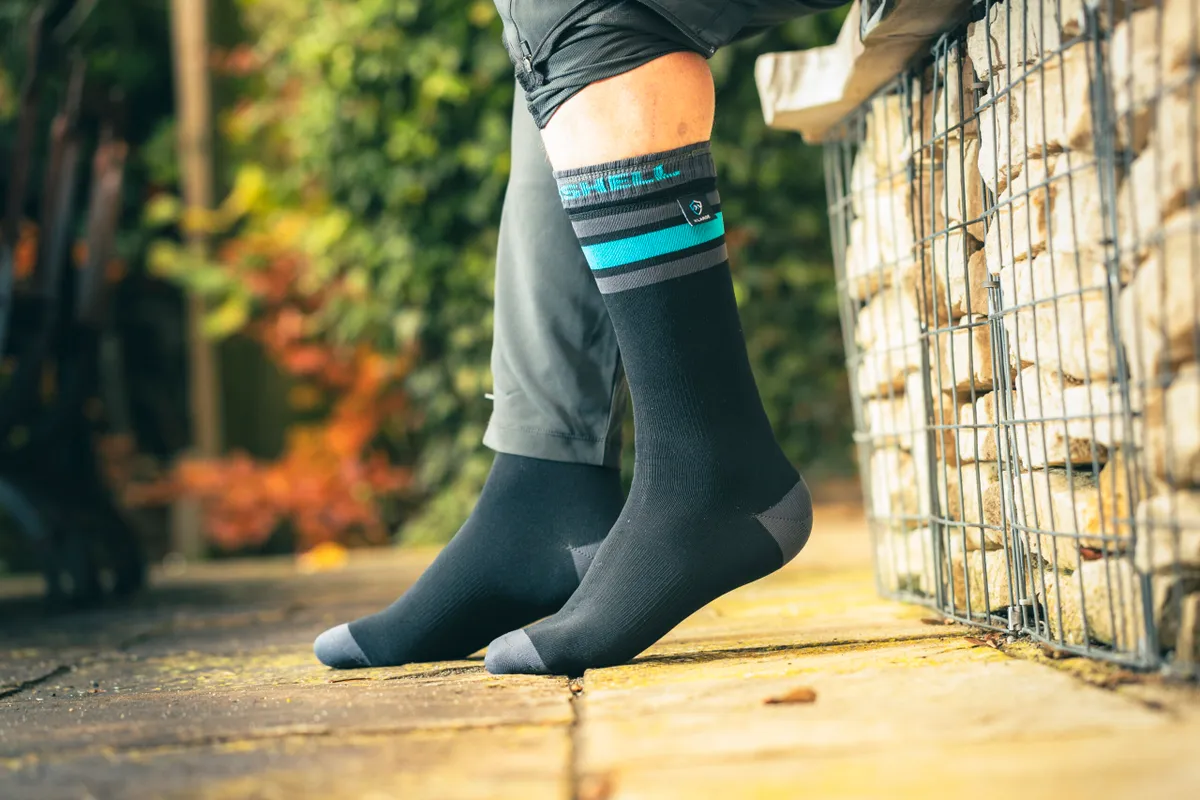Waterproof socks blend all-day comfort and durability with breathable waterproof performance, keeping your feet warm and dry.
They are a great way to add extra protection on the wettest winter rides or continue using your summer cycling shoes in cold, wet weather.
In this article, we explain everything you need to know about waterproof socks and review some of our favourites.
How do waterproof socks work?

Waterproof socks rely on a triple-layer design that keeps water out while remaining as breathable, durable and comfortable as possible.
They consist of a durable outer layer, a waterproof and breathable-membrane mid-layer, and a comfortable and moisture-wicking inner.
The mid-layer is where the magic happens. A micro-porous, waterproof, breathable membrane expels sweat and humid air while preventing water from entering. This is made possible by the tiny pores in the membrane, which are big enough to allow water vapour (sweat) to escape, but not so big as to allow water droplets to pass through.
The sock’s inner has to be comfortable for long days of use, and to wick sweat from your foot so the membrane mid-layer can expel it. The best waterproof socks will use materials with antibacterial properties, such as Merino wool.
Will waterproof socks keep my feet dry?
In short, yes, waterproof socks will keep your feet dry, even when cycling in heavy rain.
However, the design and quality of the socks will impact upon how effective they are and for how long.
The sock’s top opening is its weak spot, but most options feature an elasticated cuff to prevent any water ingress from above. Additionally, wearing waterproof trousers over your socks can reduce the risk of water running down your legs and into your socks.
It makes sense to invest a little bit of extra cash and purchase a product from a reputable brand to ensure you get a good-quality membrane. Some brands, such as Sealskinz, offer a lifetime waterproof guarantee.
As with all wet-weather gear, there is a sliding scale of price and performance. However, there is no reason why you shouldn’t trust a quality pair of waterproof socks as much as you trust your favourite waterproof riding jacket.
Waterproof sock materials

It’s important to pay attention to the materials used, before deciding which waterproof sock is right for you.
Socks with tough outer material, such as polypropylene yarn, can withstand the rigours of cycling and shrug off the occasional snag or scrape.
The inner layer is also worth paying attention to. Many quality options will feature a Merino wool inner to provide a soft feel and good moisture wicking, as well as antimicrobial properties.
How to wash waterproof socks
Some waterproof socks will require hand washing to ensure the waterproof membrane doesn’t become damaged.
Others are rated for machine washing at up to 40 degrees, provided they are washed inside-out.
Our pick of the best waterproof socks
Senior technical editor Warren Rossiter has been busy testing waterproof cycling socks and you can read his findings below.
DexShell Ultra Dri Sport

- £34
- Pros: Impressive water resistance; warm and comfortable in horrendous conditions
- Cons: Add volume, which can affect your shoe fit
If you want your feet to stay comfortable in the worst conditions, look no further than the Ultra Dri Sport socks from waterproof equipment specialists DexShell.
These are some of the best foul-weather socks available. Warren says he hasn’t tried anything better for wet and cold weather.
The only caveat is the Ultra Dri Sports add volume to your feet, which can impact how your regular shoes fit.
Giro Xnetic H20

- £39.99 as tested
- Pros: Superb fit; less bulk than typically waterproof socks; great protection
- Cons: Not the warmest option; only available in black
The Giro Xnetic H20 socks differ from the competition thanks to their slim, stretchy design.
As a result, the fit is as good as a ‘normal’ winter sock, so they don’t make your favourite shoes uncomfortable.
Like any ‘waterproof’ garment, don’t expect total protection in an extended deluge, but pair these with a great pair of winter boots and you’ll be getting some of the best protection available without compromising your performance and comfort.
Also consider…
Altura Endurance waterproof socks

- £30 as tested
- Pros: Comfortable, warm without being clammy, very well-priced
- Cons: Will wet out in heavy rain
Altura’s take on the waterproof sock combines a seamless knitted outer layer with a ribbed cuff and a soft more open-weave lining. Sandwiched between these two elements is a waterproof membrane, called Rainguard.
They wick moisture well and breathability is very close to a standard thick winter cycling sock.
The issue arises when the weather turns truly foul. In a deluge of rain, the membrane does its best to keep water at bay, but the ribbed cuff becomes overwhelmed and completely wets out.
For the damp conditions of late autumn/early winter, or the dying days of winter and the start of spring, however, these offer a layer of protection that's most welcome.
Alternatives to keep your feet warm and dry
Waterproof socks aren’t for everyone. Some won’t like the thicker feeling and construction, especially those with narrower or tighter shoes.
You can also keep your feet dry with overshoes, which create a water and windproof barrier that sits over the top of your riding shoes.
The other option is to invest in waterproof winter cycling shoes, but these will likely prove too hot in the warmer months.
